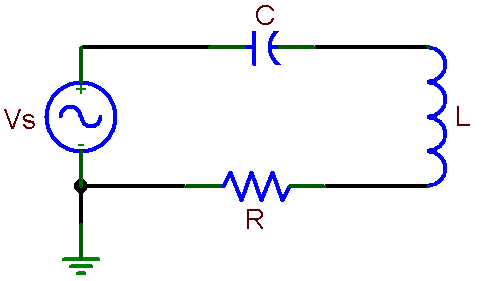|
EE291 - LABORATORY VIII RESONANCE CIRCUITS OBJECTIVES Demonstrating resonance phenomena in RLC circuits. Measurements of resonance characteristics and their comparison with theory. INTRODUCTION Resonance is one of the most important and general phenomenon in almost all branches of science and technology. For example, in mechanical systems a resonance is often seen in vibrations of a beam or a spring supporting a mass. Vibrations are caused by transfer of the potential energy stored by the beam deflection or the spring contraction to the kinetic energy of the moving mass, back and forth in a periodic motion. In electrical circuits the energy stored in the form of the electric field in a capacitor is transferred to the electric current in the circuit in which inductance plays a role equivalent to the inertial mass in a mechanical system. The equations describing both resonances are identical, only their coefficients have values related to mechanical (mass, spring constant) or electrical (capacitance, inductance) parameters. Another important analogy between the two systems is that the vibrations can be damped; by friction in mechanical systems and by resistance in electrical circuits. The resonance can be very useful in such devices as oscillators in radio transmitters or electronic watches. More often, however, they can be harmful by generating unwanted wide deflections of mechanical systems (bridges, airplane wings, etc.) or oscillations of voltage and current. Controlling or preventing unwanted resonance is an important aspect of engineering design. Since every electrical component, or even a connecting wire, has some capacitance and inductance there is a potential for resonance in every circuit. As you already know, the smaller the values of inductance and capacitance, the higher the resonance frequency. That is why design of high frequency circuits is so much more difficult as even small inductance and capacitance of connections plays a role. In this set of experiments you will explore resonance in a series RLC circuit, which have the resonance in relatively low and easy to handle frequency range.
Sketch the so called resonance curve for the series resonance circuit in Fig. 7. Put on the vertical axis the current (or voltage across resistor R) and log f on the horizontal axis. Indicate the resonance frequency fo and the width of the resonance curve (the bandwidth), which is the interval Df = 2pG between two frequencies at which the power dissipated in the circuit is ½ of the maximum. Calculate these numbers for specific component values which you may use in the laboratory, for example: R = 1k, C = 1nF, L = 50 mH. Hint: Note that the three components are connected in series with a voltage source, so it is easy to write an expression for the current (using complex numbers). The current reaches maximum (resonance) for a certain frequency at which the total circuit impedance is equal to R (what is the phase of the current at this frequency?). At half power frequencies the current drops to I/Ö2. Once you have the expression for current you may well use it in a spreadsheet program (such as MS Excel) or use some other software (such as Matlab) to calculate and plot the resonance curve (ratio VR/VS as a function of log f). You will need it also for your report. Alternatively, you may simulate the circuit operation with PSPICE.
|



